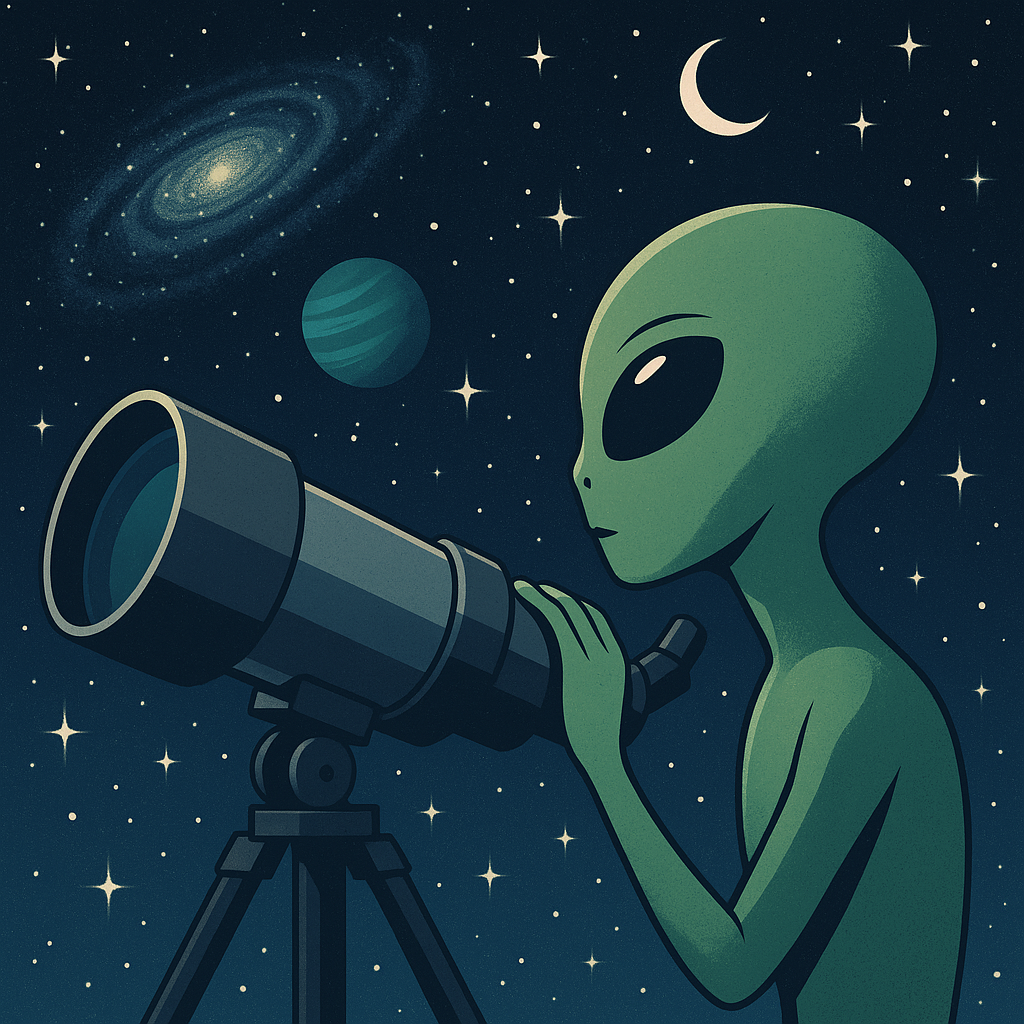1. 외계인은 천문학의 부록이 아니다
천문학은 별, 행성, 은하를 연구하는 학문이지만, 그 끝에는 늘 한 가지 질문이 따라붙습니다. “거기 누가 있나요?”
외계 생명체 탐사는 별 관측의 ‘사이드 퀘스트’처럼 보일 수 있지만, 사실상 천문학의 핵심 중 하나입니다. 우주를 이해한다는 건 단순히 ‘어디까지 있는지’ 아는 게 아니라, ‘거기에 누가 사는지’까지 포함되니까요.
2. 전파망원경은 우주 도청 장치?
라디오 천문학은 외계 생명 탐사의 주력 도구입니다. 거대한 전파망원경은 별빛 대신 우주의 ‘소리’를 잡아내죠.
미국의 아레시보 망원경(2020년 붕괴 전)이나 중국의 FAST 망원경은 은하 곳곳에서 오는 전파를 분석합니다. 혹시 모를 ‘Hello, Universe’ 신호를 기다리면서요. 영화 콘택트의 장면처럼, 단순한 잡음 속에서 인위적인 패턴을 찾는 것이 목표입니다.
3. 외계행성 사냥꾼들
외계인을 찾으려면 먼저 그들이 살 수 있는 집부터 찾아야 합니다. 케플러 우주망원경과 TESS는 수천 개의 외계행성을 발견했습니다. 그중 일부는 ‘골디락스 존(Goldilocks Zone)’ — 물이 액체 상태로 존재할 수 있는 거리 — 안에 위치합니다. 지구와 비슷한 조건이라면, 생명체가 있을 가능성이 높아지죠.
천문학자들은 이 후보 행성의 대기를 분석해 산소, 메탄, 이산화탄소 농도를 체크합니다. 이는 ‘혹시 거기서 바비큐를 굽고 있나?’를 과학적으로 확인하는 방법이기도 합니다.
4. UFO는 과학의 대상일까?
대중이 말하는 UFO와 천문학자의 외계 생명 연구는 조금 다릅니다. UFO 목격담의 대부분은 대기현상, 드론, 인공위성 플레어(스타링크 반짝임 등)로 설명됩니다. 하지만 천문학계는 이를 단순 부정하기보다, ‘확인되지 않은 비행체’라는 원래 의미에 충실합니다.
즉, “그게 외계인 비행선일 확률은 매우 낮지만, 0은 아니다”라는 태도죠.
5. 만약 연락이 온다면?
SETI(외계 지적 생명체 탐사) 프로그램은 신호를 수신하면 국제 과학 커뮤니티에 즉시 공유하도록 규정하고 있습니다. 하지만 연락이 온다고 해서 바로 ‘지구 회의’가 열리진 않습니다. 먼저 신호가 인위적인지, 자연현상인지 철저히 검증합니다.
게다가, 우리 쪽에서 먼저 답장을 보낼지 여부는 전 세계적인 논쟁이 될 겁니다. ‘외계인에게 우리 주소를 알려도 될까?’라는 질문은 과학뿐 아니라 철학, 정치, 윤리까지 건드리니까요.
6. 결론 — 외계인은 천문학을 더 흥미롭게 만든다
외계 생명체의 존재는 아직 증명되지 않았지만, 그 가능성은 천문학 연구의 방향을 넓혀줍니다. 별 하나를 관찰할 때마다 ‘혹시 그 옆 행성에서 누군가 나를 보고 있나?’라는 상상을 하게 되니까요.
결국, 외계인과 천문학의 관계는 ‘증거 없는 설렘’에서 시작해, 점점 정밀한 데이터와 기술로 좁혀가는 과정입니다. 아직은 “우주에 혼자인가?”라는 질문에 답하지 못했지만, 그 답을 찾는 여정이야말로 천문학의 가장 인간적인 얼굴일지도 모릅니다.
7. 음소분석 코너
1. proven
• 발음기호: /ˈpruː.vən/ → **강세(ˈ)**가 **첫 음절(pro-)**에 옴
• 발음방법(한국어 표기): 프루븐 (첫 음절을 조금 더 길고 강하게)
• 뜻: 입증된, 증명된
• 음소분석:
• /p/ — [p] 무성 양순 파열음 (입술을 닫았다가 터뜨림)
• /r/ — [r] 혀를 말아올려 진동 없이 소리냄
• /uː/ — [uː] 길게 내는 후설 고모음 (lube의 oo) ← 강세 포함 길게
• /v/ — [v] 유성 순치 마찰음 (아랫입술과 윗니로 소리냄)
• /ə/ — [ə] 슈와, 약하게 발음되는 중성모음 (sofa의 a)
• /n/ — [n] 유성 치경 비음 (혀끝이 윗잇몸에 닿아 콧소리)
2. footnote
• 발음기호: /ˈfʊt.noʊt/ → **강세(ˈ)**가 **첫 음절(foot-)**에 옴
• 발음방법(한국어 표기): 풋노우트 (첫 음절 ‘풋’을 더 강하게)
• 뜻: 각주, 부연설명
• 음소분석:
• /f/ — [f] 무성 순치 마찰음 (아랫입술과 윗니로 마찰)
• /ʊ/ — [ʊ] 짧고 둥근 후설 고모음 (book의 oo) ← 강세 있는 짧고 탄력 있는 소리
• /t/ — [t] 무성 치경 파열음
• /n/ — [n] 유성 치경 비음
• /oʊ/ — [oʊ] 이중모음, 입술을 둥글게 했다가 풀면서 발음
• /t/ — [t] 무성 치경 파열음

👽 Aliens and Astronomy — The Science of Finding Our Cosmic Neighbors
1. Aliens Are Not Just a Footnote in Astronomy
Astronomy studies stars, planets, and galaxies, but at the end of it all, one question always lingers: “Is anyone out there?”
Searching for extraterrestrial life might seem like a “side quest” to stargazing, but it’s actually one of astronomy’s core goals. Understanding the universe isn’t just about knowing where things are — it’s also about knowing who might be living there.
2. Radio Telescopes — The Universe’s Eavesdropping Devices
Radio astronomy is the primary tool for alien-hunting. Giant radio telescopes detect the “sounds” of the cosmos instead of light.
The Arecibo Observatory (before its collapse in 2020) and China’s FAST telescope scan the galaxy for radio waves. They wait for a possible “Hello, Universe” signal, much like in the movie Contact. The goal is to find artificial patterns hidden among the static.
3. Hunting for Alien Homes
To find aliens, you first need to find their homes. The Kepler Space Telescope and TESS have discovered thousands of exoplanets. Some of them are located in the Goldilocks Zone — the distance from a star where liquid water can exist. Earth-like conditions raise the odds of life.
Astronomers analyze the atmospheres of these candidate planets, checking for oxygen, methane, and carbon dioxide. It’s basically a scientific way of asking, “Are they having a barbecue over there?”
4. UFOs — Science or Speculation?
The UFOs in pop culture and the extraterrestrial research done by astronomers are different things. Most UFO sightings turn out to be atmospheric phenomena, drones, or satellite flares (like those from Starlink). Still, astronomy doesn’t dismiss them outright.
The scientific stance is: “It’s probably not an alien spacecraft… but the probability is never zero.”
5. What If They Contact Us?
The SETI (Search for Extraterrestrial Intelligence) program has protocols: if a signal is received, it must be shared with the international scientific community. But that doesn’t mean a “Global Earth Meeting” happens instantly. First, the signal must be confirmed as artificial and not a natural event.
The bigger debate? Whether we should respond. Revealing our “address” to extraterrestrials raises questions of science, philosophy, politics, and ethics.
6. Conclusion — Aliens Make Astronomy More Exciting
The existence of alien life hasn’t been proven, but the possibility broadens astronomy’s horizons. Every time we observe a star, we can’t help but wonder: “Is someone on a nearby planet watching me too?”
In the end, the relationship between aliens and astronomy begins with “evidence-free curiosity” and moves toward precision through data and technology. We may not have answered “Are we alone in the universe?” yet — but the search itself might be the most human part of astronomy.
#외계인 #천문학 #SETI #외계행성 #전파망원경 #우주탐사 #골디락스존 #UFO #외계생명 #케플러망원경